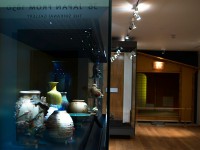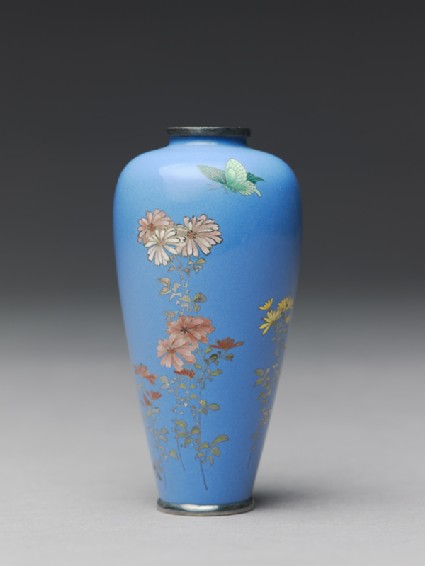Room 36 | Japan from 1850 gallery
Explore the major technical and creative developments in arts and crafts of Japan after 1850 and visit the Ashmolean's tea house.

Galleries : 6 objects
Show search help- Reference URL
Actions
Vase with chrysanthemums and a butterfly
-
Details
- Associated place
-
Asia › Japan › Honshū › Kyōto prefecture › Kyoto (place of creation)
- Date
- c. 1903
- Artist/maker
-
workshop of Namikawa Yasuyuki (1845 - 1927)
- Material and technique
- metal, with applied cut silver, and inlaid with silver wire cloisonné enamel
- Dimensions
-
9.2 cm (height)
4.1 cm (diameter)
- Material index
- Technique index
-
cut,
- Object type index
- No. of items
- 1
- Credit line
- Purchased with the assistance of the Story Fund, 2000.
- Accession no.
- EA2000.48
-
Further reading
Impey, Oliver, and Joyce Seaman, Japanese Decorative Arts of the Meiji Period 1868-1912, Ashmolean Handbooks (Oxford: Ashmolean Museum, 2005), no. 36 on p. 76, pp. 8, 22, & 74, illus. pp. 76-77
Glossary
cloisonné
-
cloisonné
Decorative technique in which wires are attached to a metal body and coloured enamels are applied between the wires.
Location
Objects are sometimes moved to a different location. Our object location data is usually updated on a monthly basis. Contact the Jameel Study Centre if you are planning to visit the museum to see a particular object on display, or would like to arrange an appointment to see an object in our reserve collections.
Galleries
Collection trails
Publications online
-

Japanese Decorative Arts of the Meiji Period
Small vase of meiping shape with chrysanthemums and a butterfly in cut silver and enamel on a pale blue ground. Signed: Kyōto Namikawa stamped in the silver base.
In 1903, Yasuyuki's sole entry in the Fifth National Domestic Exposition was a small brush-pot; what confidence! Of this, the judges commented "the few delicate bamboos look as if they were brush-strokes on a dark purple ground, and each leaf is carved as if it were a brushstroke". In other words, as can be seen here, Yasuyuki has shaped the 'wire' in almost a reversal of the cloisonné technique, so that the wire becomes a major part of the picture instead of merely outlining the picture. This is the logical next step after the shaping of the wire seen in [EA1988.1].
Notice
Objects may have since been removed or replaced from a gallery. Click into an individual object record to confirm whether or not an object is currently on display. Our object location data is usually updated on a monthly basis, so contact the Jameel Study Centre if you are planning to visit the museum to see a particular Eastern Art object.
© 2013 University of Oxford - Ashmolean Museum









